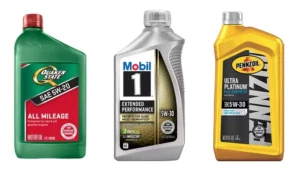Understanding the different types of car fluids can feel like learning a new language. Each fluid has a unique color, and the green one often raises eyebrows. So, “which car fluid is green?“. Let’s delve into the world of your vehicle’s lifelines and get to know more about these green car fluids. Spoiler alert: it’s the green car fluid and the green power steering fluid!
Table of contents
Introduction
Your car relies on a variety of fluids to function optimally, each serving a unique purpose. Recognizing these fluids by their colors is a key step towards better car maintenance. The green fluid in cars is typically either antifreeze (coolant) or certain types of power steering fluid. In this comprehensive guide, we’ll explore these two green car fluids in detail.
The Green Car Fluid: Antifreeze/Coolant

The most common green fluid you’ll encounter in your car is the antifreeze or coolant. It’s the unsung hero that keeps your engine running smoothly, regardless of whether it’s freezing cold or blazing hot outside.
What Does Antifreeze Do?
Antifreeze serves the critical role of maintaining the engine’s temperature within optimal ranges. It prevents the engine from overheating in hot weather and freezing in cold conditions. Additionally, antifreeze also protects the engine and cooling system components from corrosion.
Why Is Antifreeze Green?
The green color in antifreeze isn’t a natural characteristic of its chemical composition. Manufacturers add green dye to help distinguish the coolant from other fluids in your vehicle. The green antifreeze is typically an ethylene glycol-based coolant, which has been the industry standard for many years.
How Often Should You Change Antifreeze?
Antifreeze isn’t a lifetime fluid; it needs changing periodically. Most manufacturers recommend changing antifreeze every 30,000 to 50,000 miles, or about every 2-3 years. However, some modern coolants are long-life variants and may only need changing every 5 years or 60,000 miles. Always refer to your car’s manual for the specific recommendation.
Green Power Steering Fluid

The other green fluid you might find in your car is power steering fluid. Although not as common, certain types of this fluid can appear green.
What Does Power Steering Fluid Do?
Power steering fluid is the hydraulic fluid that allows the power steering system to function. It transmits power in the steering system, making it easier for you to steer your vehicle.
Why Is Some Power Steering Fluid Green?
The green color in power steering fluid, like antifreeze, comes from a dye added by manufacturers. This helps differentiate it from other car fluids. The actual color can vary by brand and type, with some appearing clear, amber, or even red.
How Often Should You Change Power Steering Fluid?
Power steering fluid is also not a lifetime fluid. It’s typically recommended to change the power steering fluid every 50,000 to 100,000 miles. However, if you notice any difficulty in steering, hear noises when turning the wheel, or the fluid appears dark or dirty, it might be time for a change. Again, your vehicle’s manual will provide the most accurate guideline.
Spotting Green Fluid Leaks and Troubleshooting

Finding a puddle of green fluid under your car can be alarming. It’s likely either antifreeze or power steering fluid. Leaks should be addressed immediately to prevent further damage.
In case of a coolant leak, you might notice your car’s temperature gauge reading higher than usual or your car may start overheating. Another sign of a coolant leak could be a sweet smell – this is a characteristic of ethylene glycol, a key component of most antifreeze.
If the power steering fluid is leaking, you might notice the steering of your car becoming difficult or stiff. You may also hear a whining or squealing noise, especially when turning corners.
How to Check for Green Fluid Leaks

Here are some steps to check if your vehicle has a green fluid leak:
- Check the Ground: Look for any green fluid on the ground where your car is parked.
- Inspect the Fluid Reservoirs: Check the coolant and power steering fluid reservoirs for low levels.
- Look for Puddles in the Engine Bay: Open the hood and look for any green puddles or damp areas around the coolant system and power steering system.
- Visit a Mechanic: If you’re unsure, it’s always best to consult a professional mechanic.
Remember, the quicker you address these issues, the less damage they are likely to cause to your vehicle.
Conclusion

Knowing your car’s fluids and their colors, such as the green antifreeze or power steering fluid, is like knowing your car’s language. It can help you maintain your vehicle’s performance and longevity, and even save you from expensive repairs. Regularly checking these fluids, and addressing any leaks promptly, is an integral part of responsible car ownership. So the next time someone asks, “Which car fluid is green?“, you’ll have the answer at your fingertips!
We hope this comprehensive guide has been informative and enjoyable. Stay tuned for more content that demystifies your car’s inner workings!











